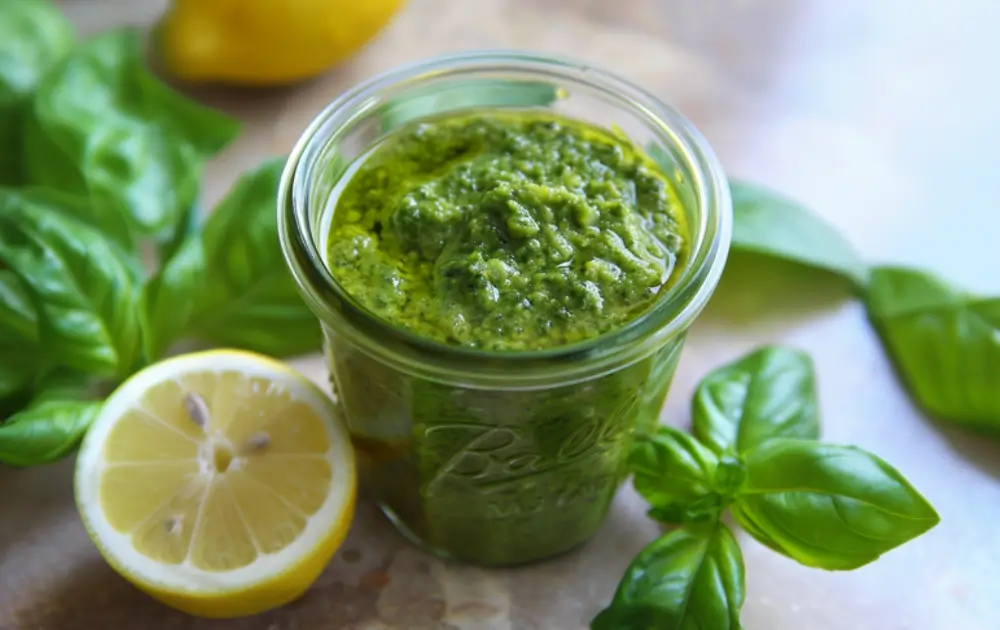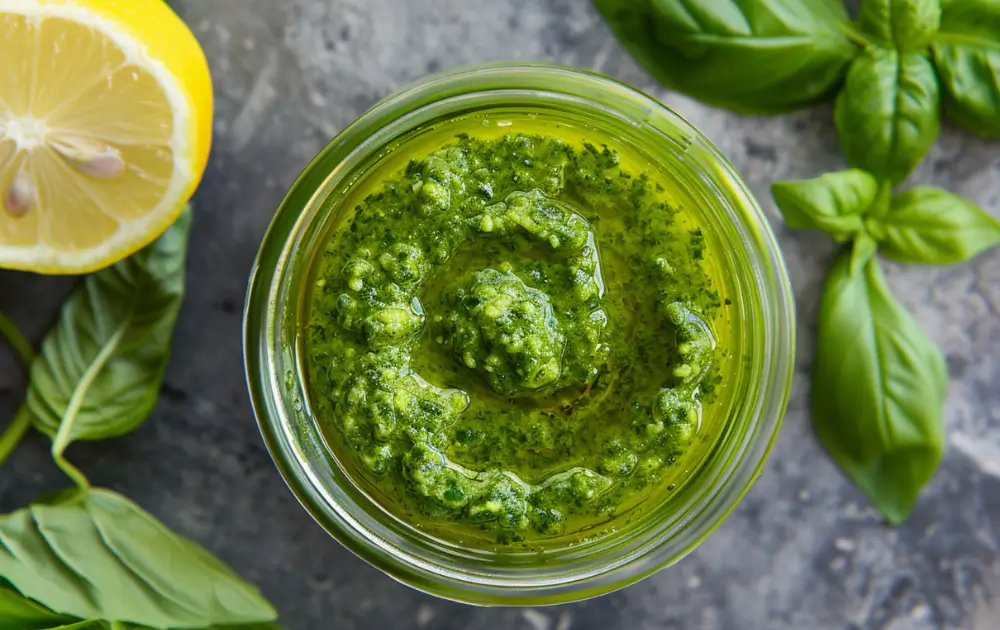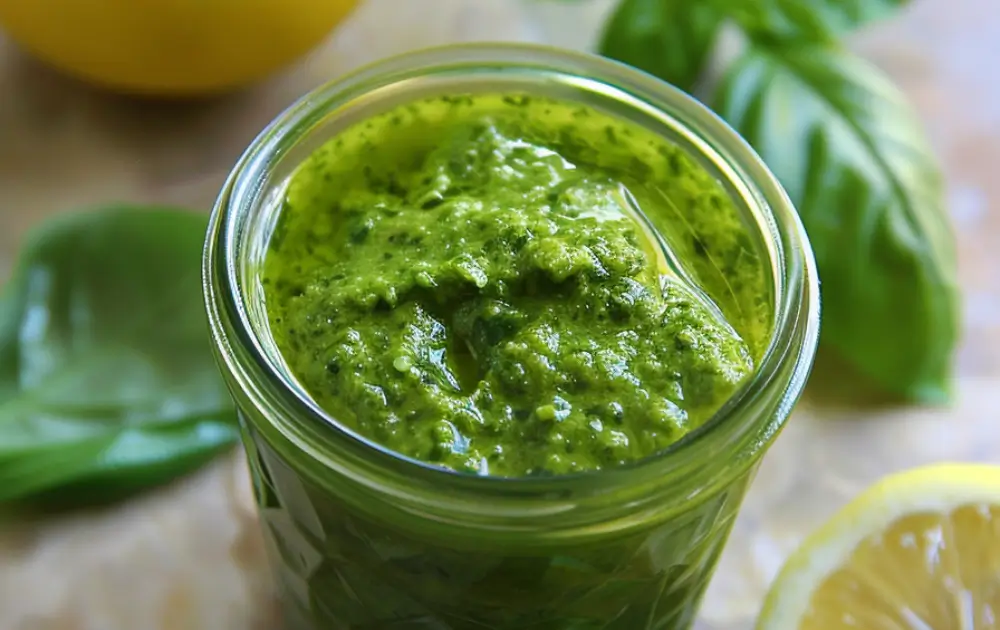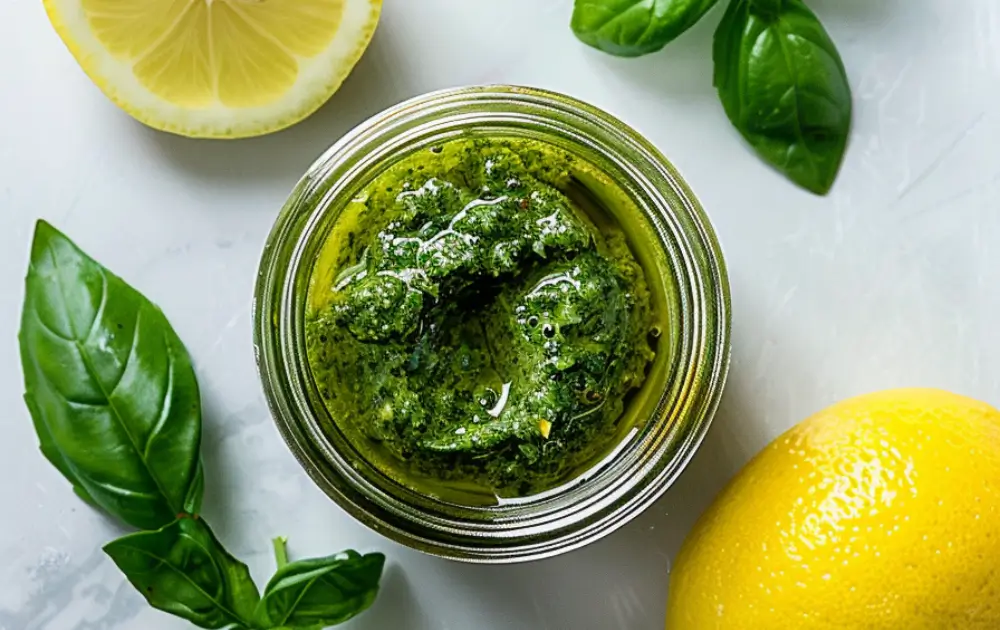Introduction to Basil Pesto
Basil pesto is a vibrant and flavorful sauce that originates from Italy and has become a staple in kitchens worldwide. Made with fresh basil leaves, shredded Parmesan cheese, extra virgin olive oil, pine nuts, garlic, and lemon juice, this sauce is both versatile and delicious. It can be used in a variety of dishes, from pasta and pizzas to sandwiches and salads, adding a rich, herby flavor that enhances the overall taste of any meal. The combination of fresh ingredients and simple preparation makes basil pesto a favorite among cooks who appreciate fresh, homemade cuisine.
Selecting Quality Ingredients
The key to a great basil pesto is using high-quality, fresh ingredients. Start with fresh basil leaves, which should be bright green and not wilted. Using high-quality extra virgin olive oil will add a fruity depth to the pesto, and freshly shredded Parmesan cheese will melt better and mix smoothly compared to pre-shredded varieties. Raw pine nuts provide a creamy texture and a slight sweetness when blended, while fresh garlic adds a pungent kick that is essential to pesto’s signature flavor. A splash of fresh lemon juice will not only add a hint of freshness but also help preserve the vibrant green color of the basil.
Preparing the Ingredients
Before making the pesto, wash the basil leaves gently and pat them dry to remove any excess moisture, which can dilute the flavor and affect the consistency of the pesto. Lightly toast the pine nuts in a dry skillet over medium heat until golden to enhance their flavor and crunch. Shred the Parmesan cheese finely to ensure it blends seamlessly into the mixture. Peel and mince the garlic cloves so they distribute evenly throughout the pesto. Preparing your ingredients this way ensures a smooth and well-balanced pesto.
Blending Techniques
To blend the pesto, use a food processor or blender for the best results. Start by adding the basil leaves, pine nuts, minced garlic, and a pinch of salt and pepper to the processor. Pulse these ingredients until they are coarsely chopped. With the processor running, slowly drizzle in the olive oil until the mixture becomes smooth and emulsified. Add the Parmesan cheese and pulse just a few more times to mix it through. Be careful not to over-process to maintain some texture in the pesto.
Serving and Storing Suggestions
Basil pesto is best served fresh but can also be stored for later use. If not using immediately, pour the pesto into a jar and cover the surface with a thin layer of olive oil; this will help prevent oxidation and maintain its bright green color. Seal the jar tightly and refrigerate for up to a week or freeze for several months. Serve your basil pesto drizzled over cooked pasta, spread on crusty bread, or as a dip with fresh vegetables. The aromatic and tangy flavors of the pesto make it a versatile condiment that brings a touch of Italian cuisine to any dish.
Enhancing Flavors with Additions
Experimenting with additional ingredients can elevate the flavor profile of your basil pesto. For a nuttier essence, consider substituting walnuts or almonds for the pine nuts, or mix different nuts together for a complex flavor. Adding a bit of ricotta or cream cheese will give the pesto a creamier texture, ideal for spreads or dips. For those who enjoy a bit of heat, a dash of crushed red pepper flakes can introduce a spicy kick. Incorporating sun-dried tomatoes or olives can add a savory depth that complements the freshness of the basil beautifully.
Utilizing Pesto in Various Dishes
Basil pesto is incredibly versatile and can be incorporated into numerous dishes to enhance their flavor. Spread it on sandwiches for a herby, moist layer that adds depth to meats and cheeses. Swirl it into soups or stews just before serving for a fresh flavor boost. It’s also perfect for marinating chicken or fish, providing a herbaceous coating that complements the natural flavors of the proteins. Additionally, mixing pesto into salad dressings or tossing it with roasted vegetables can transform simple dishes into flavorful delights.
Health Benefits of Basil Pesto Ingredients
Basil pesto not only enhances the taste of dishes but also brings several health benefits, thanks to its nutrient-rich ingredients. Basil itself is known for its anti-inflammatory properties and high levels of antioxidants, which can help fight free radical damage in the body. Extra virgin olive oil is a good source of monounsaturated fats, beneficial for heart health. Pine nuts, though small, are packed with vitamins and minerals, including vitamin E and magnesium. Incorporating pesto into your diet can contribute to a healthy eating pattern while adding immense flavor to your meals.
Creative Presentation Ideas
When serving basil pesto, presentation can significantly enhance the dining experience. For an elegant appetizer, spoon pesto over fresh burrata cheese accompanied by cherry tomatoes on a platter. Drizzle pesto atop grilled bruschetta for a vibrant and appealing starter. When serving pasta with pesto, garnish with additional grated Parmesan and a few basil leaves for a professional touch. Using pesto as a base layer on pizza before adding toppings creates a visually appealing and tasty alternative to traditional tomato sauce.
Pesto Making Workshops
Hosting a pesto-making workshop can be a fun and interactive way to engage with friends, family, or the community. Participants can learn about the history of pesto, its variations, and the techniques for making it at home. Providing a range of ingredients for customization, such as different types of nuts, cheeses, and add-ins, allows attendees to create their unique take on the classic recipe. These workshops not only educate participants on culinary skills but also promote the enjoyment of fresh, homemade food.
Maximizing Flavor with Proper Technique
Achieving the best flavor from basil pesto involves more than just mixing ingredients; it requires attention to technique. When blending the ingredients, pulse instead of letting the processor run continuously to avoid overheating the basil, which can lead to bitterness. If using a mortar and pestle, crush the ingredients gently; this traditional method releases essential oils slowly and can enhance the depth of flavor in the pesto. Always taste the pesto after blending and adjust the seasoning with salt or lemon juice if necessary. This attention to detail ensures that the pesto maintains its vibrant color and fresh flavor.
Seasonal Variations of Pesto
Basil pesto can be adapted to the seasons by incorporating different greens and herbs available throughout the year. In spring, use tender spinach or arugula as a substitute or in addition to basil for a lighter version. During summer, experiment with adding fresh cilantro or parsley for a vibrant twist. In the autumn, consider blending in kale or Swiss chard, which provides a hearty depth suitable for cooler weather. Each seasonal variation not only enhances the flavor profile but also adds nutritional diversity to your diet.
Pairing Pesto with Beverages
Pairing basil pesto with the right beverage can elevate a meal significantly. For white wine enthusiasts, a crisp Pinot Grigio or a light Sauvignon Blanc complements the fresh, herbaceous notes of pesto perfectly. If you prefer red wine, choose a lighter red like Pinot Noir that won’t overpower the delicate flavors of the pesto. For non-alcoholic options, a sparkling water with a squeeze of lime or a mint-infused iced tea can refresh the palate, balancing the richness of the olive oil and cheese in the pesto.
Educating Children on Flavors
Introducing children to making and enjoying basil pesto can be a delightful way to educate them about flavors and cooking. Kids can participate in picking fresh basil from a garden or a store and learn about the smells and textures of different ingredients like garlic and cheese. Teaching children to make pesto can also involve lessons in measuring ingredients and operating kitchen equipment safely under supervision, providing a hands-on culinary education that emphasizes the joy of creating and tasting their own food.
Sustainable Ingredient Sourcing
Sourcing ingredients sustainably for basil pesto can impact both the environment and the quality of the dish. Opt for locally grown, organic basil and garlic, which support local farmers and reduce the ecological footprint associated with long-distance transportation. Choosing pine nuts from sustainable sources or substituting them with other nuts that are more readily available locally can also contribute to a more environmentally friendly cooking practice. These efforts in sustainable sourcing not only promote a healthier planet but also ensure that the pesto is as fresh and flavorful as possible.
Exploring International Pesto Variations
Pesto is traditionally Italian, but exploring international variations can broaden its culinary scope and introduce new flavors to your palate. For instance, replace pine nuts with toasted sesame seeds and add a bit of soy sauce to craft an Asian-inspired pesto, perfect for noodle dishes. Experiment with Middle Eastern flavors by incorporating tahini and cumin. Mexican-style pesto might include roasted pepitas and cilantro instead of basil. Trying different herbs and nuts based on regional cuisines not only adds diversity to your cooking but also tailors pesto to complement a variety of international dishes.
Utilizing Pesto in Snacks and Appetizers
Basil pesto can transform simple snacks and appetizers into gourmet delights. Spread it on toasted baguette slices to create bruschetta, top with cherry tomatoes, and a sprinkle of salt for a quick and tasty starter. Mix pesto into cream cheese for a flavorful dip served with crackers or vegetable sticks. Stuff mini peppers with a mixture of pesto and goat cheese, then bake until the peppers are tender. Use pesto as a topping for deviled eggs, adding a spoonful on top of the yolk mixture for a punch of flavor. These small bites are perfect for parties, offering a burst of pesto flavor in every nibble.
Promoting Health with Nutrient-Rich Ingredients
Basil pesto is not just flavorful—it’s also packed with nutrients that promote good health. Basil acts as a natural anti-inflammatory and is rich in antioxidants, which can help combat stress and aging. The nuts traditionally used in pesto are excellent sources of healthy fats and protein, essential for heart health and energy. Garlic, another key ingredient, is known for its immune-boosting properties. By regularly incorporating pesto into your diet, you can enjoy not only its flavor but also its health benefits, making it a delicious addition to a balanced diet.
Food Pairing and Menu Planning
When planning a menu, consider dishes that pair well with basil pesto to create a cohesive meal. For a main course, pesto pairs excellently with grilled chicken or fish, providing a herbaceous lift to these proteins. For a vegetarian option, drizzle pesto over roasted vegetables or stir into a risotto for added depth and richness. Pesto also works well in pasta dishes, either as a sauce for spaghetti or a stir-in for pasta salads. When planning your menu, include a range of dishes that allow pesto’s versatility to shine, enhancing the overall dining experience with its robust flavor.
Hosting Pesto-Themed Cooking Parties
Organizing a pesto-themed cooking party can be a fun way to engage with friends and family while sharing cooking tips and enjoying good food. Invite guests to create their own versions of pesto, providing a variety of herbs, nuts, and cheeses to choose from. Set up a tasting station where everyone can sample the different pestos with a selection of bread, pasta, and vegetables. This interactive culinary event not only makes for a delightful gathering but also encourages creativity in the kitchen, allowing guests to discover new favorite combinations and take home ideas for their own cooking.
Frequently Asked Questions about Basil Pesto
- Can I use different types of nuts in pesto? Absolutely! While pine nuts are traditional, you can use walnuts, almonds, or even pistachios for a unique twist. Each type of nut will impart a different flavor and texture to the pesto.
- How long does homemade pesto last in the refrigerator? Homemade pesto can last in the refrigerator for up to one week if stored properly. Ensure it’s in an airtight container and drizzle a thin layer of olive oil on top to preserve freshness and prevent oxidation.
- Is there a dairy-free alternative for Parmesan cheese in pesto? Yes, for a dairy-free version, you can substitute nutritional yeast for Parmesan cheese. It provides a similar umami flavor that complements the other pesto ingredients.
- Can basil pesto be frozen for later use? Basil pesto freezes exceptionally well. Pour it into an ice cube tray, freeze, and then transfer the cubes to a freezer bag for long-term storage. This way, you can thaw only what you need for future use.
- What can I do if my pesto is too thick? If your pesto is too thick, simply thin it with a bit more olive oil or a splash of water to reach your desired consistency. Stir well to integrate the additional liquid.
Conclusion
Basil pesto is a delightful and versatile sauce that enhances a wide array of dishes. From traditional pasta to innovative appetizers, its robust flavor profile brings depth and freshness to meals. By understanding how to select quality ingredients, blend them effectively, and utilize the pesto in various culinary applications, you can transform simple dishes into flavorful masterpieces. Whether you’re making a quick weeknight dinner or entertaining guests, incorporating basil pesto into your cooking repertoire is sure to impress with its vibrant colors and rich flavors. Moreover, hosting pesto-themed cooking events or exploring variations of the traditional recipe can make cooking an engaging and enjoyable experience.

Basil Pesto
- Total Time: 10 minutes
- Yield: 1 cup
- Diet: Vegetarian
Description
Basil Pesto is a classic Italian sauce bursting with fresh herb flavor. Made with a simple blend of basil, Parmesan cheese, pine nuts, garlic, and olive oil, this vibrant sauce is perfect for dressing pasta, spreading on sandwiches, or as a dip for vegetables.
Ingredients
Instructions
Notes
- For a nut-free version, substitute pine nuts with seeds such as sunflower or pumpkin.
- If not using immediately, cover with a layer of olive oil and store in an airtight container in the refrigerator for up to one week or freeze for up to six months.
- Optional variations include adding other herbs like parsley or cilantro for a different flavor profile.
- Prep Time: 10 minutes
- Category: Sauce
- Method: Blending
- Cuisine: Italian
Nutrition
- Calories: 100
- Sugar: 0.2g
- Sodium: 75mg
- Fat: 10g
- Saturated Fat: 2g
- Carbohydrates: 1g
- Fiber: 0.5g
- Protein: 2g
- Cholesterol: 4mg




